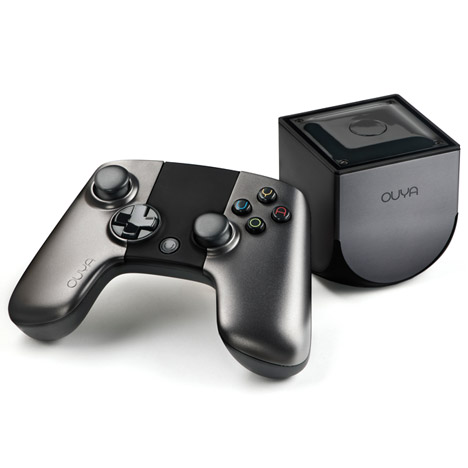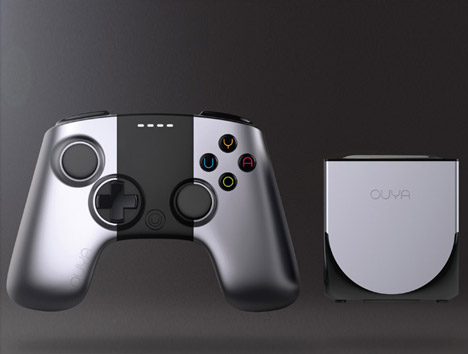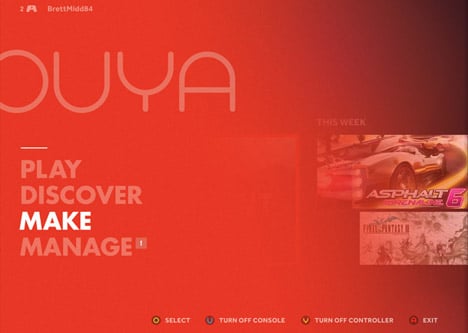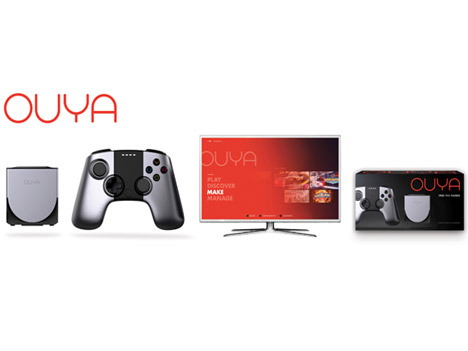
OUYA by Fuseproject
Designer Yves Behar of San Francisco studio Fuseproject has launched his OUYA open-source game console.
Fuseproject developed OUYA with technology start-up Boxer8 for open-source gaming on a TV, allowing developers to make their own games and tweak the hardware as they wish.
The anodised aluminium console designed by Behar is much smaller than rival devices thanks to the layout of components inside, which creates natural airflow and uses the aluminium as a heat-sink so a fan isn't needed.
"The radically small scale of the console allows it to live discretely anywhere," says Fuseproject. "Whether in the kitchen or the game room, the console’s small profile ensures it will stand as an accent rather than an eye sore."

Handles on the controller are also made of aluminium and frame a central touch-pad. "The use of authentic materials such as the aluminum is a quality and innovative approach not generally associated with gaming," explains the studio.
The product is based on open-design principles that encourage users to develop and adapt products themselves, so anyone can download the 3D print files, change the design and print out their own version.
Behar's case includes a lid and a spring-loaded button to access the internal components, so the shell can easily be switched. The blueprints are available on Thingiverse, the online design database operated by 3D-printer firm MakerBot (see our earlier story).
OUYA runs on Google's Android operating system and games will also be open-source and free, or available as a free trial.
"Both the interface and hardware are truly open, available to be hacked, changed and built upon in a real way. It is gaming for the people," says Fuseproject.

The development of OUYA was funded through Kickstarter, with supporters pledging £5.6 million in exchange for first access to the console, making it the second-highest earning project in the crowdfunding website's history.
Nokia became the first major manufacturer to give consumers access to its 3D design files last year, but news of open-source 3D print files has been largely dominated by the dissemination of blueprints for guns.
Other recent launches by Yves Behar include a lock that uses a smartphone instead of keys and a remote control with no buttons.
See more about open design »
See more about design by Fuseproject »
Here's some more information from OUYA:
OUYA is on a mission to bring gaming back to the TV, in an open and accessible way. From the design of the hardware to the user interface, from the logo to the name "OUYA", as creative co-founders, we built a holistic brand. The product and experience is designed to be simple and bold, using high quality materials and ergonomics, all the while remaining affordable, truly embodying OUYA’s open platform.
Inspired by the indie gaming movement that has gained momentum over the last few years, OUYA partnered with fuseproject with a dream: open sourced gaming, built for the TV. We wanted to bring gaming back to its essence, moving away from the big companies that churn out predictable and formulaic games, excluding the developers and gamers who crave a different experience. Kickstarter gave us the unique opportunity to both harness the excitement and energy around a fresh new gaming experience and raise awareness about the product within the industry and beyond. After raising over $2.5 million in 24 hours, OUYA went on to raise over $8 million.
The OUYA hardware is designed for the utmost functionality in a clean, beautiful package. The radically small scale of the console allows it to live discretely anywhere; whether in the kitchen or the game room, the console’s small profile ensures it will stand as an accent rather than an eye sore. To achieve this, we laid out the internal components of the console to create a natural airflow without the use of a fan, allowing the console to retain its small and discreet profile. Also, the anodized aluminum material acts as a heat-sink and disperses heat produced by the components.

With the design of the controller, we focused on feel and ergonomics to make a great tool for playing games. After dozens of form studies and over 50 structural prototypes, we achieved the optimal shape for the highest level of comfort and ease of use. On the surface, three vertical material areas organize the buttons visually and frame the controller’s unique touch pad. Using consumer feedback and research insight to guide our design, each button was sculpted and tuned to provide a highly functional experience. The O,U,Y,A controller buttons are laid out to correspond directly with the user interface in both order and color. From the tactile and cool to the touch aluminum handle areas, to the surface indentation on the analog sticks, to the shape and feel of the triggers, the OUYA controller is designed for optimal gaming.
OUYA's hardware reflects a belief that quality can be affordable, and that craft is as identifiable in a well made game as it is in the product's physical experience. The console form plays off the brand’s graphic elements in a fun, gestural fashion. Finally, the use of authentic materials such as the aluminum is a quality and innovative approach not generally associated with gaming, it ties the product offering together in an iconic way.
The OUYA user interface is at once simple and bold, standing apart from competitors while clearly communicating what OUYA is all about: individuality, openness and fun. The experience employs horizontal parallax scrolling in homage to classic games like Sonic and Super Mario. While working to create a sense of depth, the movement brings distinction to the medium. This type of navigation is not traditionally used in gaming experiences, but its roots in gaming history make it familiar. It immediately feels like a return to something great, to the essence of gaming that has been diluted over time.
The interface is graphically dynamic, and its prominent typography serves as a visual compass, always letting the user know where they are in the experience. The hierarchy the typography establishes makes the experience intuitive for newcomers and experienced gamers alike. From the user experience through the gamer’s interaction with the physical components, OUYA succeeds as a holistic experience. OUYA’s distinct mission of creating an open universe for gamers and developers alike lead to the building of a smart and adaptive system that brings the user closer to the experience they crave. Both the interface and hardware are truly open, available to be hacked, changed and built upon in a real way. It is "gaming for the people".